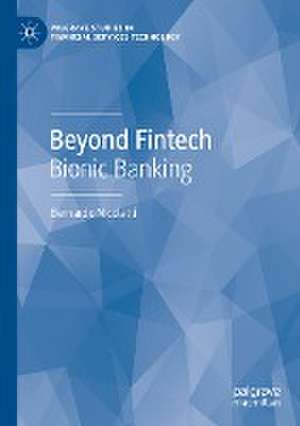Beyond Fintech: Bionic Banking: Palgrave Studies in Financial Services Technology
Autor Bernardo Nicolettien Limba Engleză Paperback – 13 apr 2023
This book determines how a bionic organization can be defined and what are its fundamental elements in the case of banking. Specifically, it investigates the two pillars of bionic enterprise which are technology and humans, as well as the core objectives and outcomes. In order to provide an exhaustive overview, the book proposes a new conceptualization of the business model of a bionic organizationon the basis of the Business Model Canvas framework. Ultimately, the study of bionic organizations is aimed to discover also how they evolved in the post pandemic phase as a result of the disruptive events generated by the spread of the pandemic.
The research on the book has been conducted through a qualitative and descriptive methodology with the intent to build further knowledge about the topic starting from the information available in literature. To provide actual evidence of the reality of bionic financial services, the book includes case studies. The organizations observed in the study have been selected since they present some of the key traits identified by the bionic enterprise theory. The book demonstrates that bionic enterprise theory can be further enriched with the conceptualization of a bionic business model in which the paradigm of collaboration between humans and machines is a recurring element.
| Toate formatele și edițiile | Preț | Express |
|---|---|---|
| Paperback (1) | 778.76 lei 43-57 zile | |
| Springer International Publishing – 13 apr 2023 | 778.76 lei 43-57 zile | |
| Hardback (1) | 783.98 lei 43-57 zile | |
| Springer International Publishing – 12 apr 2022 | 783.98 lei 43-57 zile |
Preț: 778.76 lei
Preț vechi: 949.71 lei
-18% Nou
Puncte Express: 1168
Preț estimativ în valută:
149.03€ • 154.65$ • 124.57£
149.03€ • 154.65$ • 124.57£
Carte tipărită la comandă
Livrare economică 17-31 martie
Preluare comenzi: 021 569.72.76
Specificații
ISBN-13: 9783030962197
ISBN-10: 3030962199
Pagini: 271
Ilustrații: XIX, 271 p. 22 illus., 9 illus. in color.
Dimensiuni: 148 x 210 mm
Greutate: 0.35 kg
Ediția:1st ed. 2022
Editura: Springer International Publishing
Colecția Palgrave Macmillan
Seria Palgrave Studies in Financial Services Technology
Locul publicării:Cham, Switzerland
ISBN-10: 3030962199
Pagini: 271
Ilustrații: XIX, 271 p. 22 illus., 9 illus. in color.
Dimensiuni: 148 x 210 mm
Greutate: 0.35 kg
Ediția:1st ed. 2022
Editura: Springer International Publishing
Colecția Palgrave Macmillan
Seria Palgrave Studies in Financial Services Technology
Locul publicării:Cham, Switzerland
Cuprins
Chapter 1: Bionic Banking Introduction.- Chapter 2: Bionic Banking.- Chapter 3: Bionic Banking Transformation.- Chapter 4: Bionic Banking Business Model.- Chapter 5: Bionic Banking Life Style.- Chapter 6: Bionic Banking Project.- Chapter 7: Bionic Banking Conclusions.
Notă biografică
Bernardo Nicoletti is a Professor of Operations Management at Temple University, Rome, Italy. He also provides consultancy advice and coaching in Europe, the Middle East, and Asia on ICT strategy, process improvement, and financial services. In his research, Bernardo has been particularly active in the application of the agile method and its tools to a variety of industries. He has authored 30 books on management and published 250 articles in domestic and international journals. He frequently speaks at international conferences.
Textul de pe ultima copertă
Enterprise management theories about the so-called bionic organization currently face a significant funding gap. Bionic theories have been mainly applied to enterprise lifecycle because of the presence of similarities between economic organizations and organisms. The digital transformation has offered advancements in the bionics research field which enable us to discuss bionic organizations for the first time as business realities in which humans and machines, especially robotic process automation systems and artificial intelligence tools, cooperate in executing operations.
This book determines how a bionic organization can be defined and what are its fundamental elements in the case of banking. Specifically, it investigates the two pillars of bionic enterprise which are technology and humans, as well as the core objectives and outcomes. In order to provide an exhaustive overview, the book proposes a new conceptualization of the business model of a bionic organizationon the basis of the Business Model Canvas framework. Ultimately, the study of bionic organizations is aimed to discover also how they evolved in the post pandemic phase as a result of the disruptive events generated by the spread of the pandemic.
The research on the book has been conducted through a qualitative and descriptive methodology with the intent to build further knowledge about the topic starting from the information available in literature. To provide actual evidence of the reality of bionic financial services, the book includes case studies. The organizations observed in the study have been selected since they present some of the key traits identified by the bionic enterprise theory. The book demonstrates that bionic enterprise theory can be further enriched with the conceptualization of a bionic business model in which the paradigm of collaboration between humans and machines is a recurring element.
Caracteristici
Presents the earliest results achieved by already existing bionic banking Examines and describes each of the ten building blocks (“the ten Ps”) that compose the business model canvas Provides valuable descriptions of real-world business cases of bionic financial institutions














